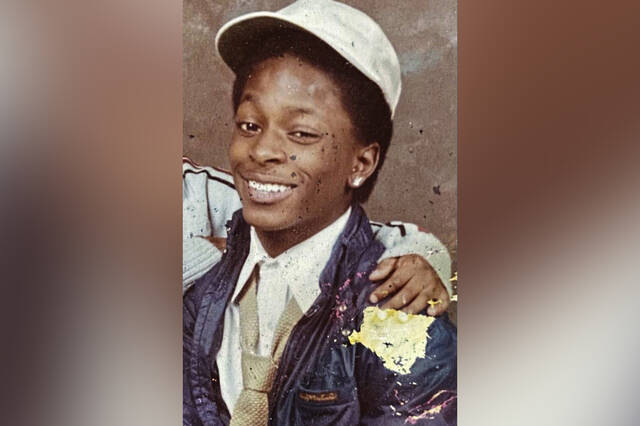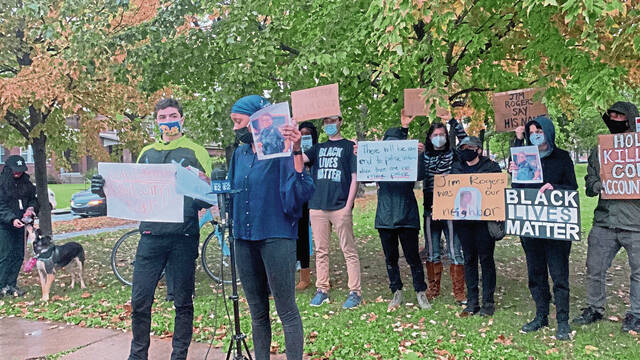The Allegheny County District Attorney’s office will use a grand jury to investigate the death of Jim Rogers, who died in October after being tased at least eight times by Pittsburgh police in Bloomfield.
Attorneys representing several officers in the case said they were notified by the DA’s office on Thursday. Subpoenas for their clients were being distributed Friday.
Mike Manko, a spokesman with the DA’s office, said he is not permitted to comment on the operation of the Allegheny County Investigating Grand Jury.
“What I can tell you is that District Attorney (Stephen) Zappala has had extensive conversations with United States Attorney Cindy Chung concerning the unnecessary death of Jim Rogers,” Manko said.
Margaret Philbin, a spokeswoman for the U.S. Attorney’s office, declined to comment.
“Zappala calling for a grand jury to investigate the officers is yet another attempt to hide from his responsibility,” said Eve Pfeiffer, a member of the organization Justice for Jim Rogers that is seeking criminal charges against the police officers involved. “He is an opportunist and a coward.”
Pfeiffer said she thinks that Zappala, along with Pittsburgh Mayor Ed Gainey and the Fraternal Order of Police, have tried to “consistently mute and obscure this case because they understand that Jim’s death indicts not only the officers, but the entire system they uphold.”
An attorney for the FOP said he couldn’t comment.
Wendy Kobee, associate city solicitor for Pittsburgh’s law department, said that state statute and the police labor contract limit her ability to talk about disciplinary action.
Bruce Antokowiak, a former federal prosecutor and law professor at Saint Vincent College, said that even if the county grand jury hears evidence in the case, the ultimate decision of whether to file charges still rests with the district attorney. All the grand jury does, he said, is make a recommendation, and then Zappala decides to follow it or not.
“It’s his decision — not the grand jury’s — that matters,” Antokowiak said. “This does not release the DA’s office from their ultimate, prosecutorial responsibility. It’s really meant as an investigative tool.”
Rogers, 54, died on Oct. 14 — a day after police were called to Bloomfield’s Harriet Street for a report of a stolen bike.
An executive summary of an internal police Critical Incident Review Board report obtained by the Tribune-Review showed that Rogers asked for help at least 13 times as he sat in the back of a patrol vehicle after he’d been taken into custody.
Although emergency medical personnel were on scene, they were never asked to check on Rogers. Instead, they were called to decontaminate Rogers’ blood from officers.
Rogers became unresponsive as he was transported to the hospital and died the next day.
The summary report said there was a series of “compounding performance failures” by Pittsburgh police personnel.
Disciplinary action has begun for nine officers at the scene that day, including two supervisors. One has already retired.
Lee Rothman represents Officer Patrick Desaro, who drove Rogers to the hospital.
“They’re putting something before the grand jury before they can even prove cause of death,” Rothman said.
He was critical of the grand jury process.
“That process is secret. It’s an incredibly powerful prosecution tool,” Rothman said, describing the process as one-sided.
“What is presented is with a specific intent in mind, and that’s not necessarily justice,” Rothman continued. “Justice is served when there’s an adversarial process where people can evaluate evidence from varying standpoints.”
In the grand jury, he said, evidence is not subject to scrutiny.
The Allegheny County District Attorney’s office has used the grand jury often in recent years, including for reviews of broader issues such as security at Western Psychiatric Insitute and Clinic after a 2012 shooting there led to the deaths of two people. It also was used when two teachers at Plum Borough School District were accused of having sexual relationships with students.
More often, the grand jury has been used in homicide investigations in which law enforcement fears potential retaliation against witnesses.
Antkowiak said that the original intent of the grand jury — which is typically made up of 23 citizens — was to protect against politically motivated prosecution.
In Allegheny County, the grand jury meets biweekly when there are matters up for its consideration. The group is empaneled for 18 months and can be extended up to an additional six months.
“In the right set of circumstances, it can be a very effective way of truly assessing a complicated and difficult matter,” he said.
In a case like the one involving Jim Rogers, Antkowiak said, there are at least nine police officers who were at the scene, as well as physical evidence, video evidence, medical records and autopsy records.
Once the evidence has been presented, the deputy prosecutor running the grand jury will make suggestions about the types of charges and elements for each of those that apply.
“The prosecutor hardly remains a disinterested neutral party in the grand jury process,” Antkowiak said. “They’re going to remain actively involved, and ultimately, the DA will have to decide whether to file charges.”
David A. Harris, a law professor at the University of Pittsburgh, agreed.
“The prosecutor controls what happens. That is the thing to remember,” Harris said “If they want an indictment, they’ll get an indictment. If they don’t, it won’t happen.”
In the case against the officers, several of their attorneys questioned what a grand jury will do, given that the medical examiner’s office, which found Rogers’ cause of death to be a lack of oxygen to his brain, ruled the manner of death as accidental.
“I find it difficult to understand how citizens of a community can establish that alleged criminal conduct would be the cause of death when a coroner cannot pinpoint, medically, the cause of death or that conduct of anyone involved in the incident caused the man’s death,” Rothman said.
Defense attorney Stephen Colafella said he was asked Thursday to accept a grand jury subpoena for his client, Officer Neyib Velazquez.
The summary report said that Velazquez had the most prolonged contact with Rogers, and was in close contact with him for about 17 minutes as he stood outside the patrol car where Rogers was held.
“Obviously, they’re going through the incident step by step,” Colafella said. “There’s been concern voiced by the family and community over the manner this was handled. They’re going to do their due diligence and investigate it.”
Patrick Thomassey represents Sgt. Carol Ehlinger, who was called to the scene after Rogers was taken into custody. He said his client is being subpoenaed to the grand jury, as well.
“We’re going to go in there and tell the truth,” he said.
In terms of potential criminal charges, Thomassey said the DA’s office could be pursuing involuntary manslaughter. Under the law, to prove that count, the prosecution must show recklessness and gross negligence, which Thomassey said could be difficult given that the manner of death was found to be accidental.
Antkowiak called that a “seriously complicating factor,” adding, “That doesn’t preclude filing a homicide charge, but it is certainly a complicating factor.”











